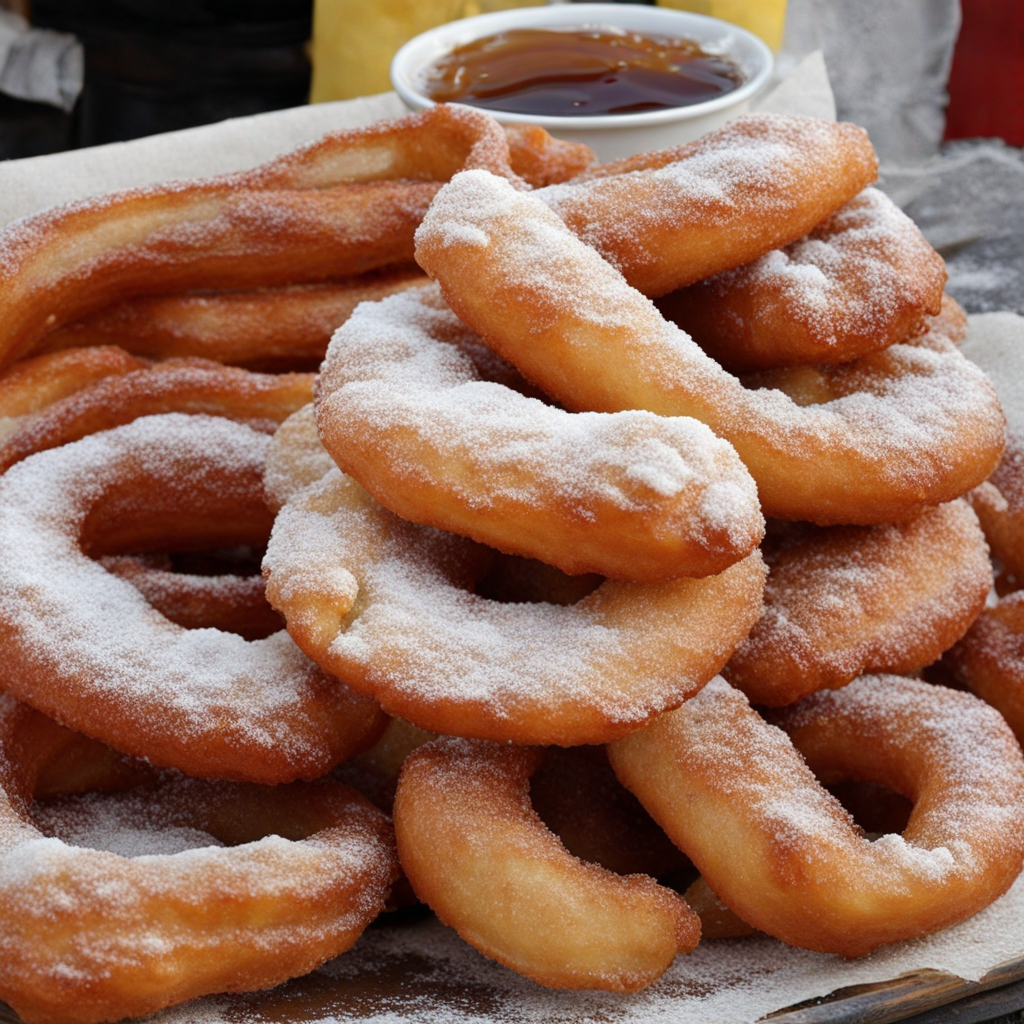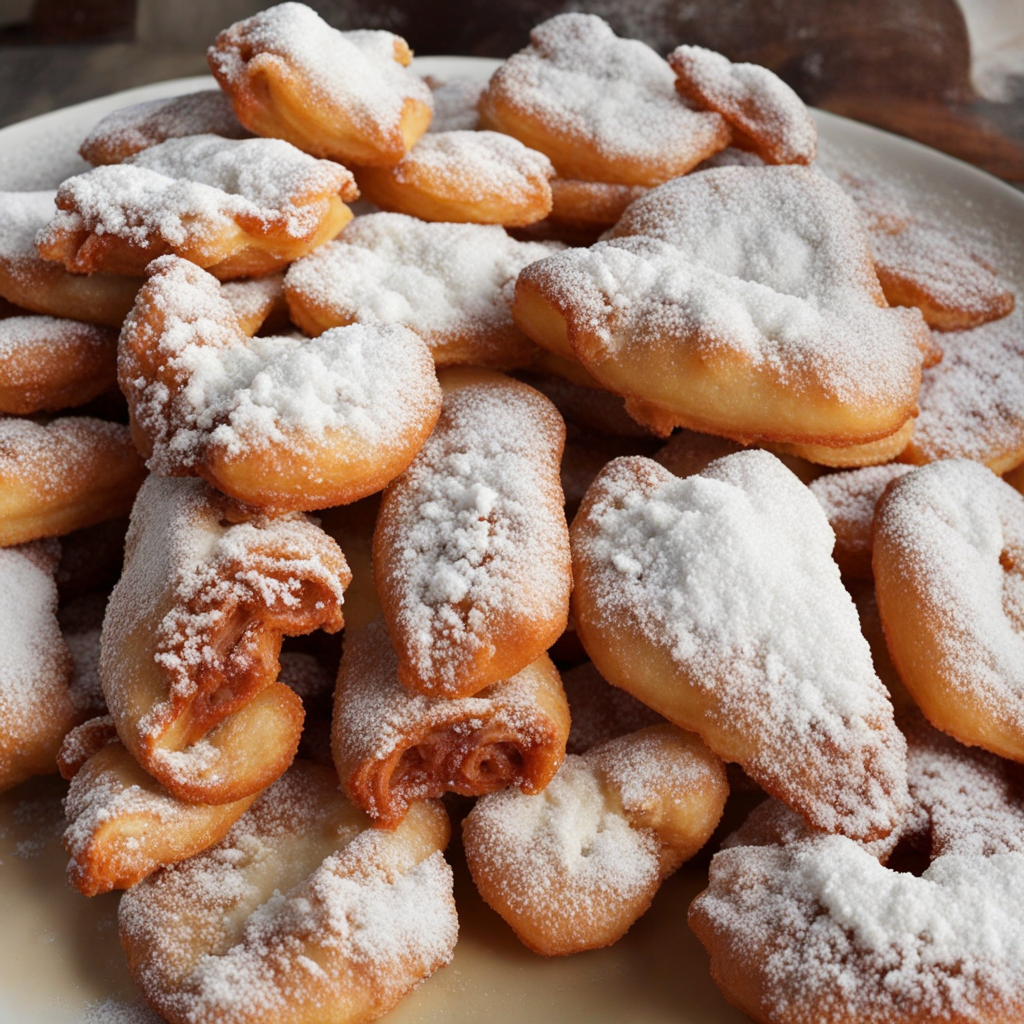Tulumbe
Tulumbe is a delightful pastry that hails from Kosovo, known for its unique texture and sweet flavor. This traditional treat is made from a dough that is typically prepared with flour, eggs, and water, which is then piped into long, spiral shapes before being deep-fried to a golden brown. The frying process gives Tulumbe a wonderfully crispy exterior, while the inside remains soft and slightly chewy, creating a delightful contrast with every bite. The pastry is often enjoyed warm, allowing the rich flavors to shine through. Once fried, Tulumbe is generously drenched in a sweet syrup, usually made from sugar, water, and a hint of lemon or rose water. This syrup not only adds a glossy finish to the pastry but also infuses it with an irresistible sweetness that perfectly complements the dough's savory notes. The syrup seeps into the pastry, ensuring that each piece is imbued with flavor, making it a truly indulgent treat. The aromatic notes of lemon or rose water elevate the overall taste experience, making Tulumbe a fragrant delight. Tulumbe is often served during special occasions and gatherings in Kosovo, making it a cherished part of the local culinary tradition. Its unique combination of textures and flavors makes it a standout dessert that can appeal to both those who appreciate traditional sweets and those seeking something new. Whether enjoyed alongside a cup of coffee or as a standalone dessert, Tulumbe promises to captivate your taste buds and transport you to the heart of Kosovo's rich food culture.
How It Became This Dish
Tulumbe: A Sweet Legacy from Kosovo #### Origins and Etymology Tulumbe is a beloved pastry originating from the Balkans, particularly popular in Kosovo. Its name is derived from the Turkish word "tulum," which means "tube." This nomenclature reflects the dessert's characteristic shape—long, tubular sweets that are deep-fried and soaked in syrup. The roots of Tulumbe can be traced back to the Ottoman Empire, which significantly influenced the culinary landscape of the Balkans during its rule from the 15th to the 20th century. The Ottoman culinary tradition brought with it a plethora of sweets, many of which were created using simple ingredients like flour, sugar, and water. Tulumbe, with its crispy exterior and syrupy sweetness, embodies this rich history, merging local ingredients with the techniques introduced by Ottoman cooks. #### Traditional Preparation The preparation of Tulumbe is an art form that has been passed down through generations. Traditionally, the dough consists of flour, water, and a hint of baking powder, creating a chewy texture once fried. To craft the Tulumbe’s distinctive shape, the dough is often piped through a funnel or pastry bag into hot oil, producing long, spiraled tubes that are fried until golden brown. Once fried, these pastries are then bathed in a sweet syrup made from sugar and water, sometimes flavored with lemon or rosewater. The syrup infuses the Tulumbe with a sticky sweetness that contrasts beautifully with its crispy exterior. This combination of textures and flavors makes Tulumbe a favorite not only in Kosovo but throughout the Balkan region. #### Cultural Significance In Kosovo, Tulumbe is more than just a dessert; it is a symbol of hospitality and cultural identity. When guests arrive, it is customary for hosts to offer sweets, and Tulumbe is often among the offerings. The act of sharing food is deeply ingrained in the social fabric of Kosovar culture, and Tulumbe has become a staple at celebrations, holidays, and family gatherings. Particularly during festive occasions such as weddings, religious holidays, and family reunions, Tulumbe is a must-have treat. It serves not only as a delicious indulgence but also as a representation of community and togetherness. The preparation of Tulumbe can even become a communal activity, with family members gathering to make the pastries in large batches, strengthening bonds and creating cherished memories. #### Evolution Through Time Over the years, Tulumbe has evolved, influenced by both cultural exchanges and modern culinary techniques. While the traditional recipe remains popular, contemporary variations have emerged. For example, some bakers experiment with different flavors, adding ingredients like chocolate, nuts, or different syrups to create unique twists on the classic Tulumbe. The rise of globalization and the internet has also played a role in the evolution of Tulumbe. Recipes have been shared across borders, allowing diaspora communities to recreate the delicacy in different parts of the world. This exchange has enabled Tulumbe to gain recognition beyond Kosovo, introducing it to new audiences who may not be familiar with Balkan cuisine. Moreover, as culinary tourism has grown in popularity, Tulumbe has found its way onto the menus of restaurants and cafes that specialize in Balkan cuisine, allowing a wider audience to experience this delicious dessert. Chefs often highlight Tulumbe as a quintessential representation of Kosovar culinary heritage, showcasing it at food festivals and cultural events. #### Tulumbe in the Modern Era In the modern era, Tulumbe continues to hold its place as a cherished dessert in Kosovo and the broader Balkan region. As more people become interested in traditional cooking methods and local ingredients, the allure of Tulumbe remains strong. Many bakeries and patisseries in Kosovo take pride in their Tulumbe, often using family recipes that have been honed over decades. In addition to its traditional role in celebrations, Tulumbe has also found its way into everyday life. Many families enjoy it as a sweet treat with coffee or tea, making it a versatile dessert that can be enjoyed at any time. The simplicity of its ingredients allows for easy preparation at home, contributing to its enduring popularity. Social media has also played a significant role in revitalizing interest in Tulumbe. Food bloggers and influencers often share recipes, tips, and stunning photographs of their creations, further inspiring new generations to engage with this traditional dish. Online cooking classes and tutorials have introduced Tulumbe to those who might not have access to traditional kitchens, allowing its legacy to continue thriving in contemporary kitchens around the world. #### Conclusion Tulumbe is more than just a pastry; it is a rich tapestry of history, culture, and community. From its Ottoman origins to its modern-day variations, Tulumbe has adapted and evolved while retaining its essence. This sweet treat not only serves as a delicious indulgence but also as a symbol of the hospitality and warmth that characterize Kosovar culture. As Tulumbe continues to be cherished by both locals and those afar, it stands as a testament to the enduring power of food to connect people, celebrate traditions, and create lasting memories. Whether enjoyed at a festive gathering, shared among friends, or made in the comfort of home, Tulumbe encapsulates the spirit of togetherness that is at the heart of every meal.
You may like
Discover local flavors from Kosovo







